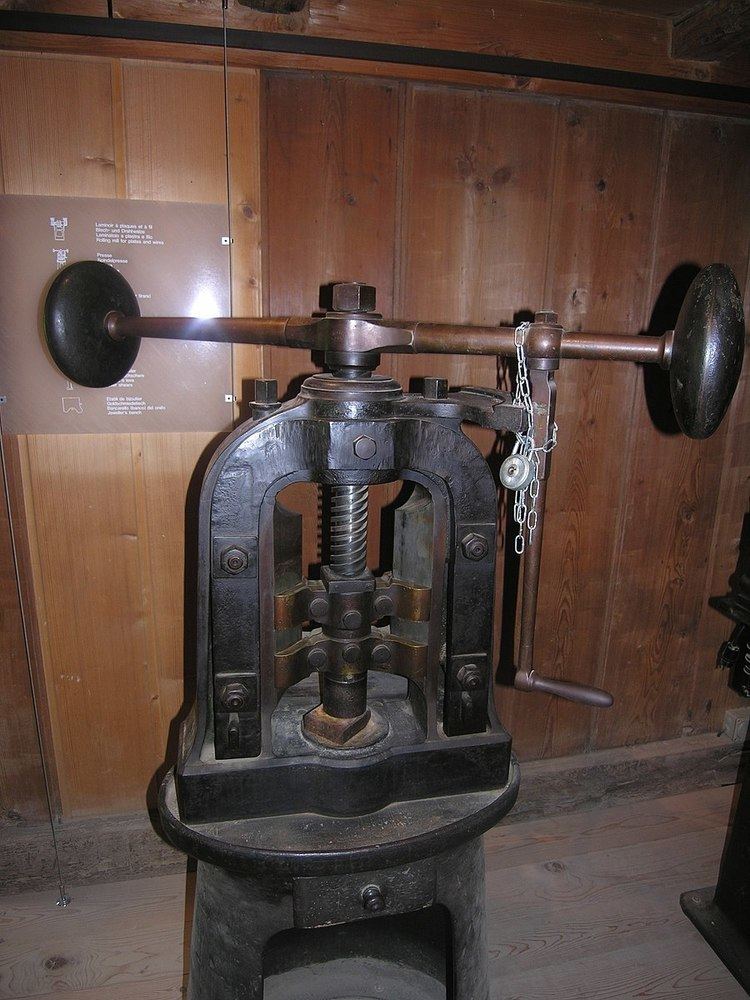 | ||
A forming press, commonly shortened to press, is a machine tool that changes the shape of a workpiece by the application of pressure. Presses can be classified according to
Contents
- An example of peculiar press structure shop press
- Some examples of presses by application
- An example of peculiar press control servo press
- Types of presses
- History
- Safety
- References
An example of peculiar press structure: shop press
A simple frame, fabricated from steel, containing a bottle jack or simple hydraulic cylinder. Good for general-purpose work in the auto mechanic shop, machine shop, garage or basement shops, etc. Typically 1 to 30 tons of pressure, depending on size and expense. Classed with engine hoists and engine stands in many tool catalogs.
Some examples of presses by application
An example of peculiar press control: servo-press
A servomechanism press, also known as a servo press or a 'electro press, is a press driven by an AC servo motor. The torque produced is converted to a linear force via a ball screw. Pressure and position are controlled through a load cell and an encoder. The main advantage of a servo press is its low energy consumption; its only 10-20% of other press machines.
When stamping, it's really about maximizing energy as opposed to how the machine can deliver tonnage. Up until recently, the way to increase tonnage between the die and workpiece on a mechanical press was through bigger machines with bigger motors.
Types of presses
The press style used is in direct correlation to the end product. Press types are straightside, BG (back geared), geared, gap, OBI (open back inclinable) and OBS (open back stationary). Hydraulic and mechanical presses are classified by the frame the moving elements are mounted on. The most common are the gap-frame, also known as C-frame, and the straightside press. A straightside press has vertical columns on either side of the machine and eliminates angular deflection. A C-frame allows easy access to the die area on three sides and require less floor space. A type of gap-frame, the OBI pivots the frame for easier scrap or part discharge. The OBS timed air blasts, devices or conveyor for scrap or part discharge.
History
Historically, metal was shaped by hand using a hammer. Later, larger hammers were constructed to press more metal at once, or to press thicker materials. Often a smith would employ a helper or apprentice to swing the sledgehammer while the smith concentrated on positioning the workpiece. Adding windmill or steam power yielded still larger hammers such as steam hammers. Drop hammers utilize an electric motor to lift the hammer, which then falls by gravity onto the work. Most modern machine presses use a combination of electric motors and hydraulics to achieve the necessary pressure. Along with the evolution of presses came the evolution of the dies used within them.
Hammers were the tool of choice for any Blacksmith, until the turning point in 1784 when a man called James Watt (a Scottish inventor and Mechanical Engineer) described the Steam Hammer. James Watt had a keen interest in steam engines and the mechanics behind it, and his invention of the steam condenser helped other engineers evolve this principle into other industries.
Eventually the steam hammer was built in 1840 based on a design by British Inventor James Nasmyth, which was revolutionary and a turning point for manufacturing with steel.
As the steam hammer was used, people made improvements and in 1891 the Bethlehem Iron Company made an enhancement that meant the steam hammer could deliver a 125-ton blow.
Safety
Machine presses can be hazardous, so safety measures must always be taken. Bi-manual controls (controls the use of which requires both hands to be on the buttons to operate) are a very good way to prevent accidents, as are light sensors that keep the machine from working if the operator is in range of the die.
